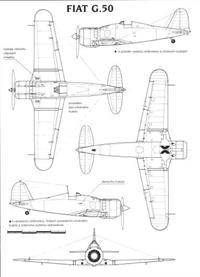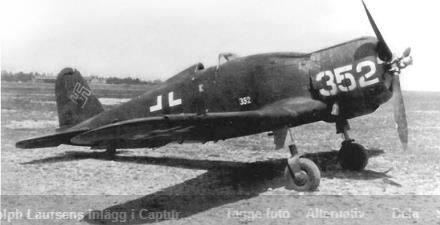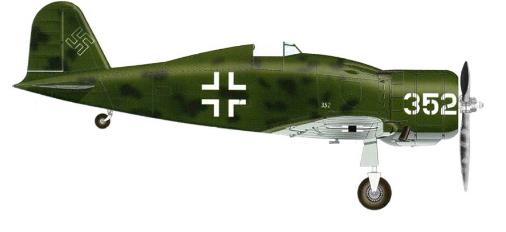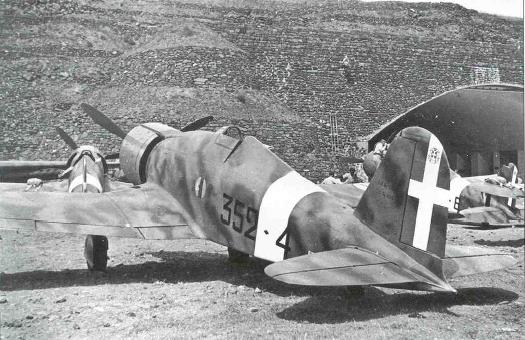




Fighter G.50 Freccia ("Arrow"), first took off on February 26, 1937 and was actually the first all-metal monoplane with retractable landing gear and constant speed propeller, which received Regia Aeronautica - RAF. The G.50 was built to meet the 1936 fighter-interceptor requirements, which also contributed to the excellent Macchi C.200.
The Fiat G.50 was powered by a Fiat A.74 RC38 14-cylinder twin-row radial geared engine with mechanical turbocharging, developing 840 hp. at 2500 rpm at an altitude of 3800 m. The Hamilton-Fiat three-bladed all-metal constant speed variable pitch propeller had a diameter of 3000 mm.
Armament. Two synchronized 12.7-mm Breda-SAFAT machine guns were located in the upper front part of the fuselage in front of the cockpit, and the fire could be fired with single shots or bursts. Each barrel had 150 rounds of ammunition.
Construction. The wing consisted of three sections: the center section of steel pipes was attached to the lower part of the fuselage, and two two-spar consoles with working skin were docked to it. The four-section slotted flaps were hydraulically operated; they retracted automatically after exceeding a certain speed. The statically and dynamically balanced ailerons had metal frames and canvas sheathing.
Only the first 45 aircraft were equipped with a closed cockpit, which had a developed canopy cover and provided a good rear view. Although the pilots did not actually object to the installation of a closed cockpit, they didn’t take much admiration for it, and eventually an open cockpit was adopted, similar to that used on the M.C.200.
The first prototype of the improved G.50bis modification took off for the first time on September 09, 1940. This model was similar to the original G.50, but received an increased fuel capacity, new radio equipment, a slightly modified fuselage profile, an armored pilot's seat, minor changes in the cockpit design and a new rudder design - with an increased chord and reduced height.
When Italy entered the war in June 1940, there were 118 Fiat G. 50-97 in combat units and 21 were awaiting delivery or were under repair.
For reasons of prestige and political ambition, the Italian government in the fall of 1940 sent a small unit of fighters and bombers to participate in the German air offensive against England. The RA headquarters preferred to use the available forces in other sectors where better results could be achieved. The RA's contribution to the Battle of Britain was unsuccessful.
The Fiat G.50 has achieved more, albeit less well-known, success in foreign air forces such as the Finnish. The Finnish government ordered 35 G. 50s at the end of 1939, just before the Soviet attack on Finland. They immediately began replacing the Gladiator fighters in HLeLv 26, but the squadron did not take part in the fighting until the armistice was concluded in March. HLeLv 26, originally based in Utti, was actively involved in the fighting in the Ladoga Lake area. The G.50 remained in service until May 1944, but since they were not adapted to operate in very cold weather, they created very serious problems in service. Other reasons for dissatisfaction were the weak weight of the volley of two machine guns and the limited flight range. The G.50 achieved some success before being replaced by a Brewster B-239 and transferred to training. In addition to two aces - Oivo Tuominen (in total 43 victories until the end of the war) and Olli Puhakka, who recorded most of the victories on the G.50, eight other aces in Finland flew it. Aerobatics master Tuominen was awarded the highest Finnish order - the Mannerheim Cross, when on August 17, 1941, piloting the G.50, he shot down 4 Soviet bombers in 4 minutes and was forced to withdraw from the battle due to the exhausted ammunition load. By the way, it is little known that several Italian volunteer pilots fought against the Russians in Finland, and one of them, Sergeant Manzozzi, was killed in action.
A total of 245 initial G.50s, 421 G.50bis aircraft, 108 training G.50Bs and a small number of experimental variants were produced.
Aircraft modifications
To master the new monoplane fighters, a two-seat modification was required. CMASA designed this variant, designated G.50B. "Sparka" made its first flight on April 30, 1940. Its serial production began in the same year. 108 of these machines were produced, which enjoyed a good reputation, and one even survived the war and served until 1948 in the fighter aviation school in Lecce.
September 9, 1940 a prototype of an improved modification of the G.50bis fighter took off. It differed from the G.50 with an increased fuel reserve, minor changes in the cockpit design, a new rudder and other minor improvements, was equipped with new radio equipment, and had an armored back of the pilot's seat. In total, CMASA and the Fiat Aeritalia plant in Turin produced 421 G.50bis fighters. Most of them, 344 planes, were produced by Fiat Aeritalia.
Several fighters were used by CMASA as flying laboratories. The first in this series was the G.50ter, equipped with a 1000-horsepower Fiat A.76 engine, which took off on July 17, 1941. However, by that time the development of this engine had stopped, and all work in this direction was quickly curtailed. Another experimental aircraft, the G.50V, made its first flight on August 25, 1941. It was equipped with a German Daimler-Benz DB 601 inline engine, for which the front part of the fuselage had to be changed. The aircraft was used to create the promising G.52 fighter, which never appeared, but became a step towards the truly successful Fiat G.55.
When it became obvious that the G.50 was outdated, they tried to turn it into a ground attack fighter. As a result, on October 3, 1942, the G.50bis ASSALTO fighter-bomber took off. Its wing was increased in span by 1372 mm due to rectangular inserts between the center section and the consoles. They were placed on an additional 12.7-mm machine gun, and the bottom was installed with a bomb rack for 150-kg bombs. On the basis of this modification, they then created the G.50bis / AN carrier-based fighter-bomber for the Aquila aircraft carrier under construction. A distinctive feature of this aircraft was the brake hook, installed in the aft fuselage. 7 single-seat G.50bis and one "twin" were converted into a deck version, which at the beginning of February 1943 entered the 160th Gruppo Autonomo ST. Italy's capitulation halted the development of this program.
| Type |
Single seat fighter |
| Engine |
1 Fiat A.74 R.C.38 with a Hamilton Standard-Fiat constant speed propeller |
| Dimensions |
Length 8,01 m , height 3,28 m , span 10,99 m , wing area 18,25 m2 , |
| Weights |
Empty 1963 kg, loaded , max. take off weight 2402 kg , fuel 316 l |
| Performance |
Max.. speed 470 km/h at 5000 m , cruising speed , range 445 km , endurance , service ceiling 10700 m , climb to 500 m 6 min. 3 sec. |
| Armament |
2 7,7 mm Breda-SAFAT machine guns |




